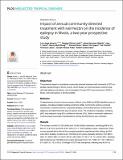Impact of annual community-directed treatment with ivermectin on the incidence of epilepsy in Mvolo, a two-year prospective study
Publication Date
2024-03-18Type
Article, Journalviews
downloads
Metadata
Show full item recordCitation
Abstract Objectives: The potential impact of cumulative community-directed treatment with ivermectin (CDTI) on epilepsy epidemiology in Mvolo County, South Sudan, an onchocerciasis-endemic area with high epilepsy prevalence, was investigated. Annual CDTI was introduced in 2002 in Mvolo, with interruptions in 2016 and 2020. Methods: Comprehensive house-to-house surveys in Mvolo (June 2020 and 2022) identified cases of epilepsy, including probable nodding syndrome (pNS). Community workers screened households in selected sites for suspected epilepsy, and medical doctors confirmed the diagnosis and determined the year of seizure onset. The incidence of epilepsy, including pNS, was analysed using 95% confidence intervals (CIs). Data on ivermectin intake and onchocerciasis-associated manifestations (itching and blindness) were collected. Results: The surveys covered 15,755 (2020) and 15,092 (2022) individuals, identifying 809 (5.2%, 95% CI: 4.8-5.5%) and 672 (4.5%, 95% CI: 4.1-4.8%) epilepsy cases, respectively. Each survey reported that a third of the surveyed population experienced skin itching, and 3% were blind. Epilepsy incidence per 100,000 person-years gradually declined, from 326.5 (95% CI: 266.8-399.1) in 2013-2015 to 96.6 (95% CI: 65.5-141.7) in 2019-2021. Similarly, pNS incidence per 100,000 person-years decreased from 151.7 (95% CI: 112.7-203.4) to 27.0 (95% CI: 12.5-55.5). Coverage of CDTI was suboptimal, reaching only 64.0% of participants in 2019 and falling to 24.1% in 2021 following an interruption in 2020 due to COVID-19 restrictions. Additionally, while 99.4% of cases had active epilepsy in 2022, less than a quarter of these had access to antiseizure medication. Conclusions: The observed decrease in epilepsy incidence despite suboptimal CDTI coverage highlights the potential impact of onchocerciasis control efforts and underscores the need to strengthen these efforts in Mvolo County and across South Sudan. As a proactive measure, Mvolo and neighbouring counties are transitioning to biannual CDTI. Furthermore, the substantial epilepsy treatment gap in Mvolo should be addressed.
Abstract/
Objectives: The potential impact of cumulative community-directed treatment with ivermectin (CDTI) on epilepsy epidemiology in Mvolo County, South Sudan, an onchocerciasis-endemic area with high epilepsy prevalence, was investigated. Annual CDTI was introduced in 2002 in Mvolo, with interruptions in 2016 and 2020. Methods: Comprehensive house-to-house surveys in Mvolo (June 2020 and 2022) identified cases of epilepsy, including probable nodding syndrome (pNS). Community workers screened households in selected sites for suspected epilepsy, and medical doctors confirmed the diagnosis and determined the year of seizure onset. The incidence of epilepsy, including pNS, was analysed using 95% confidence intervals (CIs). Data on ivermectin intake and onchocerciasis-associated manifestations (itching and blindness) were collected. Results: The surveys covered 15,755 (2020) and 15,092 (2022) individuals, identifying 809 (5.2%, 95% CI: 4.8-5.5%) and 672 (4.5%, 95% CI: 4.1-4.8%) epilepsy cases, respectively. Each survey reported that a third of the surveyed population experienced skin itching, and 3% were blind. Epilepsy incidence per 100,000 person-years gradually declined, from 326.5 (95% CI: 266.8-399.1) in 2013-2015 to 96.6 (95% CI: 65.5-141.7) in 2019-2021. Similarly, pNS incidence per 100,000 person-years decreased from 151.7 (95% CI: 112.7-203.4) to 27.0 (95% CI: 12.5-55.5). Coverage of CDTI was suboptimal, reaching only 64.0% of participants in 2019 and falling to 24.1% in 2021 following an interruption in 2020 due to COVID-19 restrictions. Additionally, while 99.4% of cases had active epilepsy in 2022, less than a quarter of these had access to antiseizure medication. Conclusions: The observed decrease in epilepsy incidence despite suboptimal CDTI coverage highlights the potential impact of onchocerciasis control efforts and underscores the need to strengthen these efforts in Mvolo County and across South Sudan. As a proactive measure, Mvolo and neighbouring counties are transitioning to biannual CDTI. Furthermore, the substantial epilepsy treatment gap in Mvolo should be addressed.

